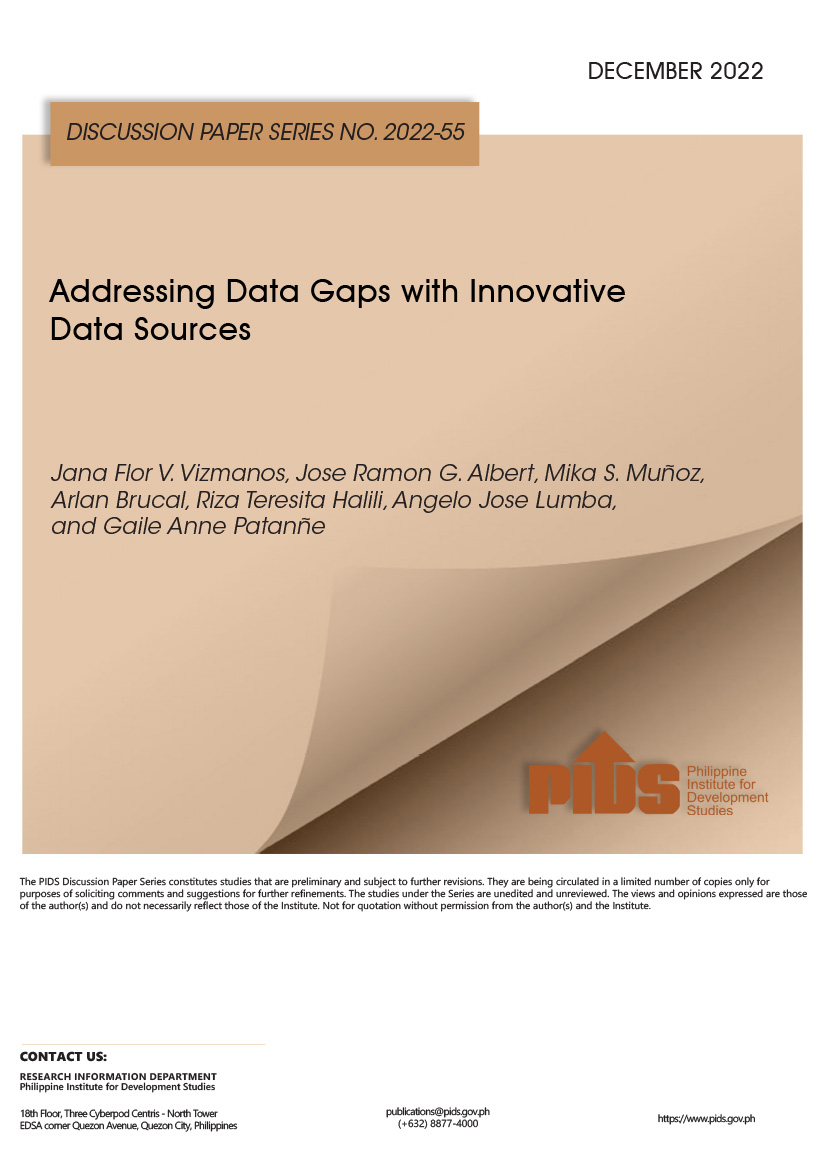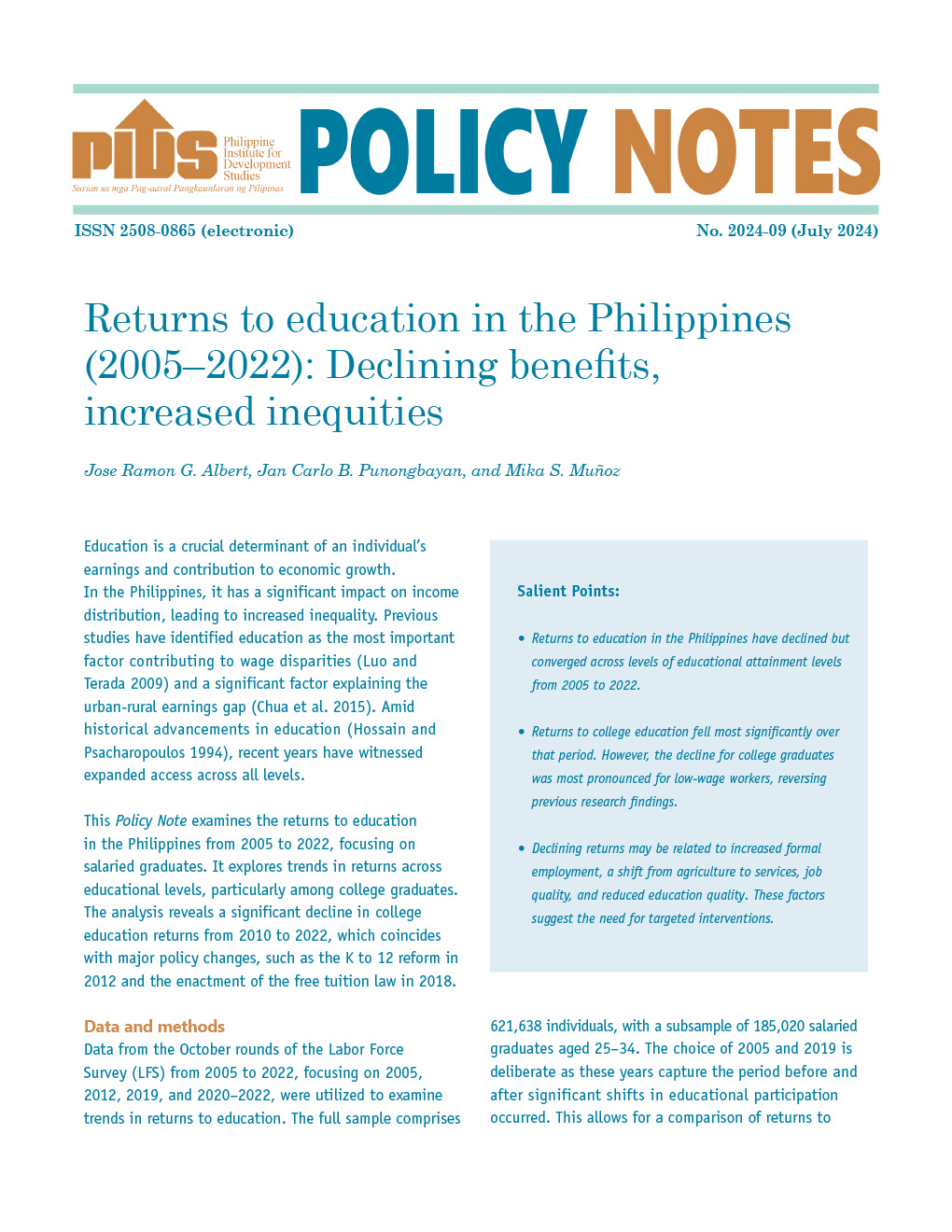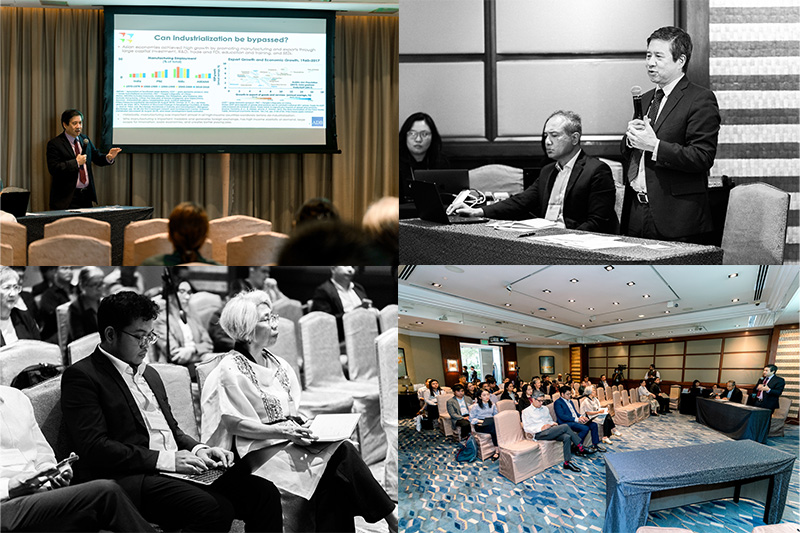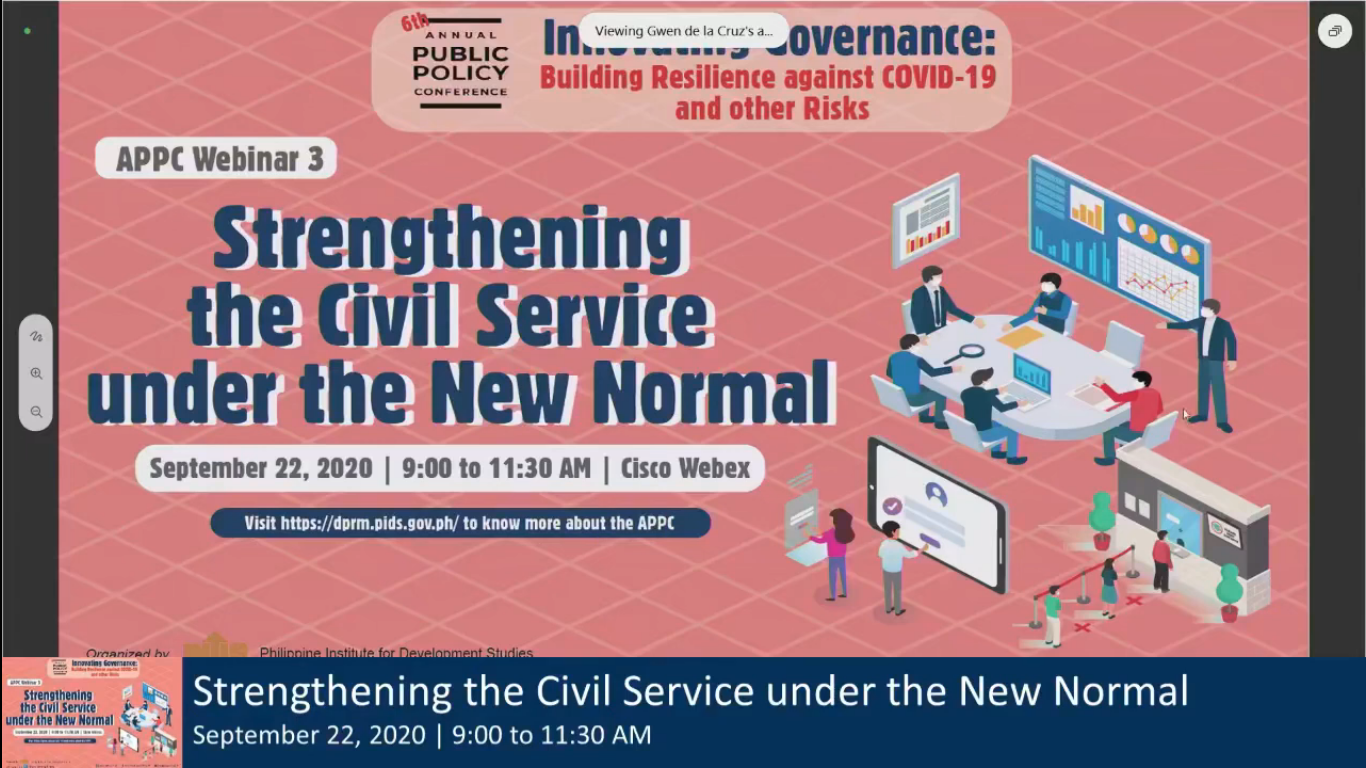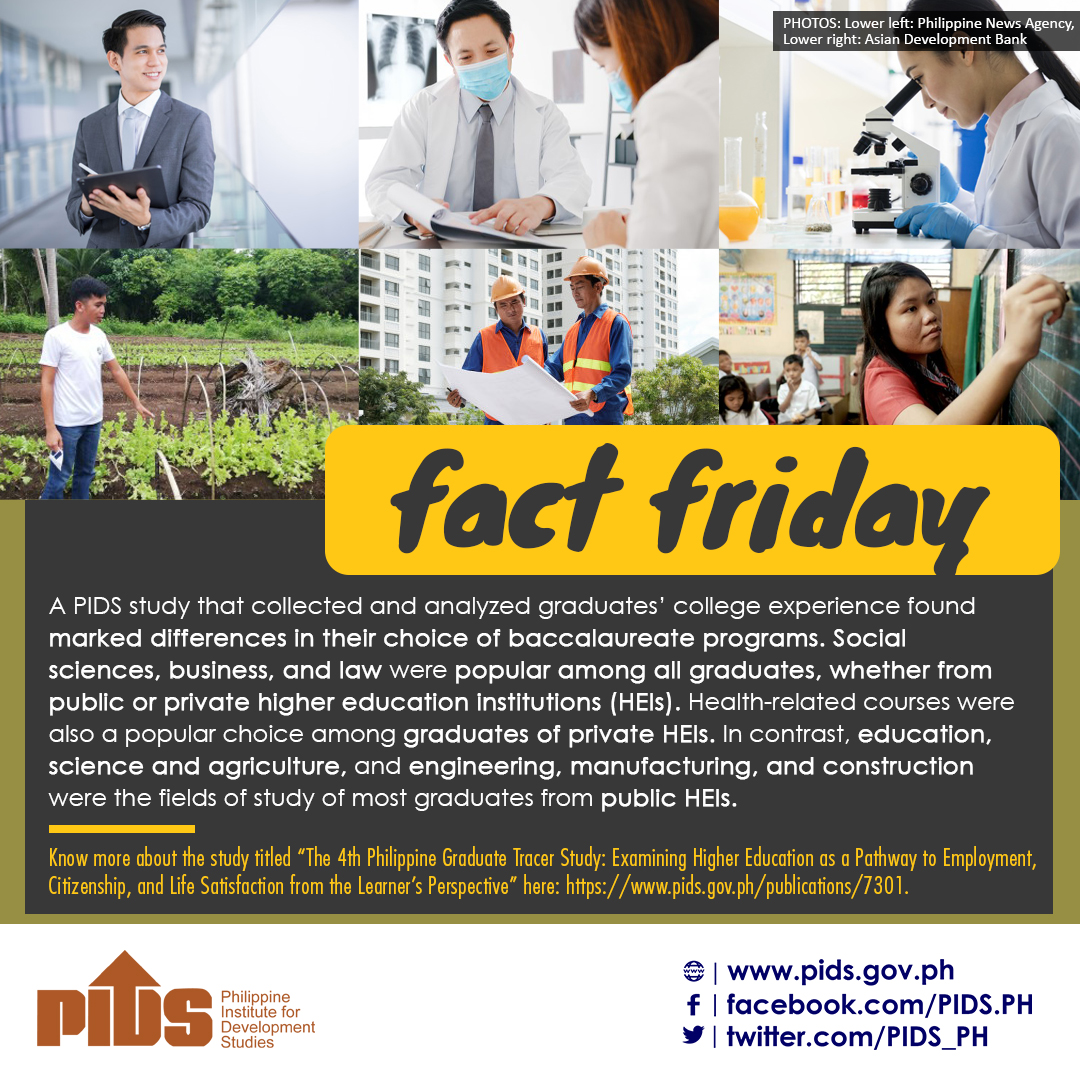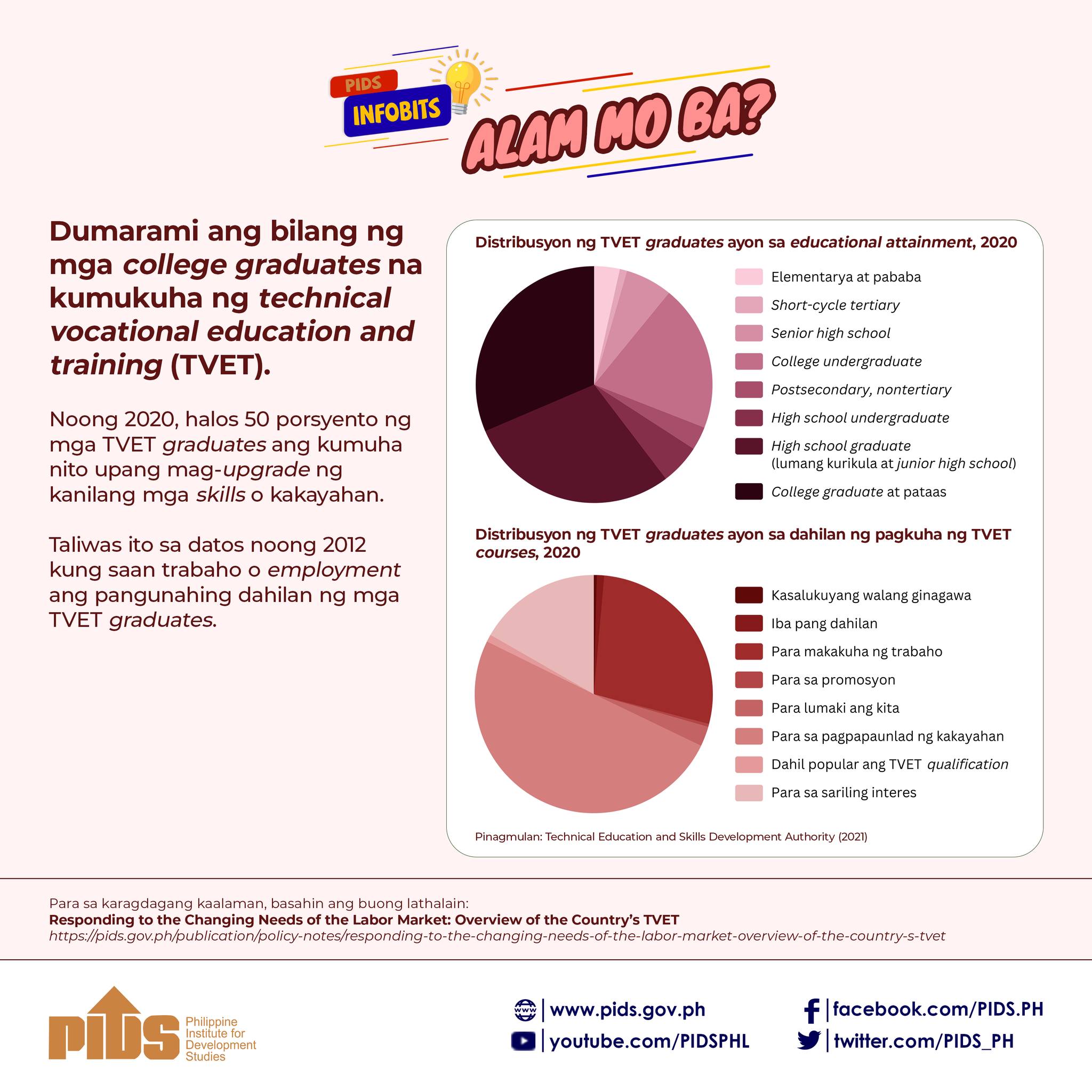ABOUT 3 IN 10 graduates of higher education institutions (HEIs) in the country feel they end up mismatched to the jobs they find after university.
This was based on the Philippine Graduate Tracer Survey (GTS) jointly conducted by state think tank Philippine Institute or Development Studies (PIDS) and the Commission on Higher Education (CHED) that looked into the college learning experience, as well as the experiences of graduates after college graduation.
The GTS, which surveyed 11,547 graduates of public and private colleges and universities in the country from academic year 2009 to 2011, aims to find out the impact of college education and training on employment outcomes to further improve the Philippine higher education system.
In her presentation at a PIDS public seminar, Melba Tutor, PIDS consultant and one of the authors of the study, pointed out that many graduates feel they were lacking the important skills required to perform their jobs better—communication, critical thinking, and problem solving skills.
In fact, 1 in every 4 graduates thinks that the outdated skills he or she learned in college is keeping him or her from getting a good job, she noted.
Even for graduates of courses requiring a Professional Regulation Commission (PRC) license, only half of them are in jobs that match their degree.
This was observed in graduates of nursing and elementary education courses where only 52.8 percent and 62.8 percent, respectively, are in jobs that match their degrees.
A separate PIDS study also identified the field of data science and analytics (DSA) where mismatch rates are high. This is despite the country’s rising demand for DSA professionals.
PIDS consultants Brenda Quismorio, Maria Antonette Pasquin, and Claire Tayco blamed this on the existing school-industry gap, or the mismatch between the skills that the industry demands and the skills that HEIs supply.
OUTDATED CURRICULA BLAMED
Quismorio, Pasquin, and Tayco revealed that this school-industry gap can be
attributed to the “country’s outdated higher education curriculum, weakness in STEM education, insufficient collaboration between the academe and the industry, inadequate instructional facilities, and poor teaching quality”.
STEM stands for science and technology, engineering, and mathematics.
As such, HEIs face difficulties in equipping their graduates with all the needed DSA competencies, with 21st century skills as the most difficult skills to teach students.
The 2016 Glossary of Education Forum defines 21st century skills as a broad set of 16 knowledge, skills, habits, and character traits, otherwise known as soft skills.
These skills exhibit cross-cutting skills essential for analytics at all levels, including, but not limited to, decision-making, planning and organizing, ethical mindset, problem-solving skills, entrepreneurship, and professional networking.
The varying DSA competency standards between the academe and the industry further intensify the school-industry gap.
For instance, existing DSA programs only equip their graduates with basic competencies set by the Commission on Higher Education (CHED). Employers, however, expect a higher level of DSA competency and proficiency to fill in DSA job roles.
This further leads to job mismatch, as companies often end up hiring wrong candidates based on incorrect expectations.
Nonetheless, the GTS noted that the new graduates’ labor force participation rate (LFPR) remains high, with almost 9 in 10 graduates in the labor force and about 8 in 10 of them employed.
This was particularly evident in graduates of secondary education and accountancy courses, the survey revealed.
The LFPR of secondary education and accountancy graduates stand at 91.3 percent
and 90.9 percent, respectively.
The LFPR is computed as the percentage of the total number of persons in the labor force to the total population 15 years old and over, and employment rates.
ARE STUDENTS TAKING THE WRONG COURSES?
The GTS study further revealed that while graduates were highly motivated by future earnings and career advancement in choosing their degree programs, the median wage per day of those surveyed is at only at PHP 460, which is slightly higher for males.
According to Tutor, college graduates are only concentrated in a few courses, and except for nursing and information technology-related courses, these courses are not the high-paying ones.
“More than 70 percent of graduates are concentrated in the top 15 courses. The top three for women are BS Nursing, Bachelor of Elementary Education, and BS in Business Administration; for men, it is BS Nursing, BS in Criminal Justice/ Criminology, and BS in Information Technology,” she explained.
The survey further revealed that only 52 percent of graduates are professionals or associate professionals, while some hold elementary occupations as housekeeping staff, manufacturing laborers, and building construction laborers, among others.
In addition, the PIDS researcher also noted that it takes some time for graduates to land their first job.
“For graduates of courses without professional license requirements, the median length of getting a job after graduation is 5 months and 12 months for those who are required to take PRC licenses,” she added.
POLICY RECOMMENDATIONS
Addressing job mismatch after college requires the joint efforts of the academe, government, and the industry.
According to Tutor, labor market information must reach students in the earlier stages of secondary education for them to better assess their alternative career paths vis-à-vis their preferences.
In addition, she recommended that college instruction must focus on substantially developing the communication, critical thinking, and problem-solving skills of students to further improve their employability.
“CHED and HEIs should formulate improvements to a student’s college life that will have desirable effects beyond employment,” she argued.
Establishing standards for degree programs that are common among stakeholders will also address the widening school-industry gap.
Citing the issues faced by the country’s DSA field, Quismorio, Pasquin, and Tayco pointed out that DSA readiness will only push forward if there is a common understanding of a DSA-ready workforce.
“A framework that can facilitate a common understanding among various stakeholders can help in aligning the demand and supply of DSA workforce in the country,” they said.
As such, they urged both HEIs and the industry to utilize the Professional Maturity Model devised by the Analytics Association of the Philippines (AAP).
The AAP model may serve as a basis for the industry in hiring DSA talents, as well as a guide for the HEIs in developing DSA ready graduates.
The study further endorses stronger government-industry-academe linkages to expand the existing market for DSA workforce in the country. (GGM, CPSD/PIDS)
This was based on the Philippine Graduate Tracer Survey (GTS) jointly conducted by state think tank Philippine Institute or Development Studies (PIDS) and the Commission on Higher Education (CHED) that looked into the college learning experience, as well as the experiences of graduates after college graduation.
The GTS, which surveyed 11,547 graduates of public and private colleges and universities in the country from academic year 2009 to 2011, aims to find out the impact of college education and training on employment outcomes to further improve the Philippine higher education system.
In her presentation at a PIDS public seminar, Melba Tutor, PIDS consultant and one of the authors of the study, pointed out that many graduates feel they were lacking the important skills required to perform their jobs better—communication, critical thinking, and problem solving skills.
In fact, 1 in every 4 graduates thinks that the outdated skills he or she learned in college is keeping him or her from getting a good job, she noted.
Even for graduates of courses requiring a Professional Regulation Commission (PRC) license, only half of them are in jobs that match their degree.
This was observed in graduates of nursing and elementary education courses where only 52.8 percent and 62.8 percent, respectively, are in jobs that match their degrees.
A separate PIDS study also identified the field of data science and analytics (DSA) where mismatch rates are high. This is despite the country’s rising demand for DSA professionals.
PIDS consultants Brenda Quismorio, Maria Antonette Pasquin, and Claire Tayco blamed this on the existing school-industry gap, or the mismatch between the skills that the industry demands and the skills that HEIs supply.
OUTDATED CURRICULA BLAMED
Quismorio, Pasquin, and Tayco revealed that this school-industry gap can be
attributed to the “country’s outdated higher education curriculum, weakness in STEM education, insufficient collaboration between the academe and the industry, inadequate instructional facilities, and poor teaching quality”.
STEM stands for science and technology, engineering, and mathematics.
As such, HEIs face difficulties in equipping their graduates with all the needed DSA competencies, with 21st century skills as the most difficult skills to teach students.
The 2016 Glossary of Education Forum defines 21st century skills as a broad set of 16 knowledge, skills, habits, and character traits, otherwise known as soft skills.
These skills exhibit cross-cutting skills essential for analytics at all levels, including, but not limited to, decision-making, planning and organizing, ethical mindset, problem-solving skills, entrepreneurship, and professional networking.
The varying DSA competency standards between the academe and the industry further intensify the school-industry gap.
For instance, existing DSA programs only equip their graduates with basic competencies set by the Commission on Higher Education (CHED). Employers, however, expect a higher level of DSA competency and proficiency to fill in DSA job roles.
This further leads to job mismatch, as companies often end up hiring wrong candidates based on incorrect expectations.
Nonetheless, the GTS noted that the new graduates’ labor force participation rate (LFPR) remains high, with almost 9 in 10 graduates in the labor force and about 8 in 10 of them employed.
This was particularly evident in graduates of secondary education and accountancy courses, the survey revealed.
The LFPR of secondary education and accountancy graduates stand at 91.3 percent
and 90.9 percent, respectively.
The LFPR is computed as the percentage of the total number of persons in the labor force to the total population 15 years old and over, and employment rates.
ARE STUDENTS TAKING THE WRONG COURSES?
The GTS study further revealed that while graduates were highly motivated by future earnings and career advancement in choosing their degree programs, the median wage per day of those surveyed is at only at PHP 460, which is slightly higher for males.
According to Tutor, college graduates are only concentrated in a few courses, and except for nursing and information technology-related courses, these courses are not the high-paying ones.
“More than 70 percent of graduates are concentrated in the top 15 courses. The top three for women are BS Nursing, Bachelor of Elementary Education, and BS in Business Administration; for men, it is BS Nursing, BS in Criminal Justice/ Criminology, and BS in Information Technology,” she explained.
The survey further revealed that only 52 percent of graduates are professionals or associate professionals, while some hold elementary occupations as housekeeping staff, manufacturing laborers, and building construction laborers, among others.
In addition, the PIDS researcher also noted that it takes some time for graduates to land their first job.
“For graduates of courses without professional license requirements, the median length of getting a job after graduation is 5 months and 12 months for those who are required to take PRC licenses,” she added.
POLICY RECOMMENDATIONS
Addressing job mismatch after college requires the joint efforts of the academe, government, and the industry.
According to Tutor, labor market information must reach students in the earlier stages of secondary education for them to better assess their alternative career paths vis-à-vis their preferences.
In addition, she recommended that college instruction must focus on substantially developing the communication, critical thinking, and problem-solving skills of students to further improve their employability.
“CHED and HEIs should formulate improvements to a student’s college life that will have desirable effects beyond employment,” she argued.
Establishing standards for degree programs that are common among stakeholders will also address the widening school-industry gap.
Citing the issues faced by the country’s DSA field, Quismorio, Pasquin, and Tayco pointed out that DSA readiness will only push forward if there is a common understanding of a DSA-ready workforce.
“A framework that can facilitate a common understanding among various stakeholders can help in aligning the demand and supply of DSA workforce in the country,” they said.
As such, they urged both HEIs and the industry to utilize the Professional Maturity Model devised by the Analytics Association of the Philippines (AAP).
The AAP model may serve as a basis for the industry in hiring DSA talents, as well as a guide for the HEIs in developing DSA ready graduates.
The study further endorses stronger government-industry-academe linkages to expand the existing market for DSA workforce in the country. (GGM, CPSD/PIDS)

